The role of Silicon in Agriculture.
Part 2. Biostimulant effects and improvement of crop resistance to biotic stress
By: Henk-Maarten Laane, MD, PhD
Director R & D Rexil Agro, Weesp-Amsterdam
*Correspondence: hm.laane@rexil-agro.com (P.B.)
Efficacy of silicon compounds
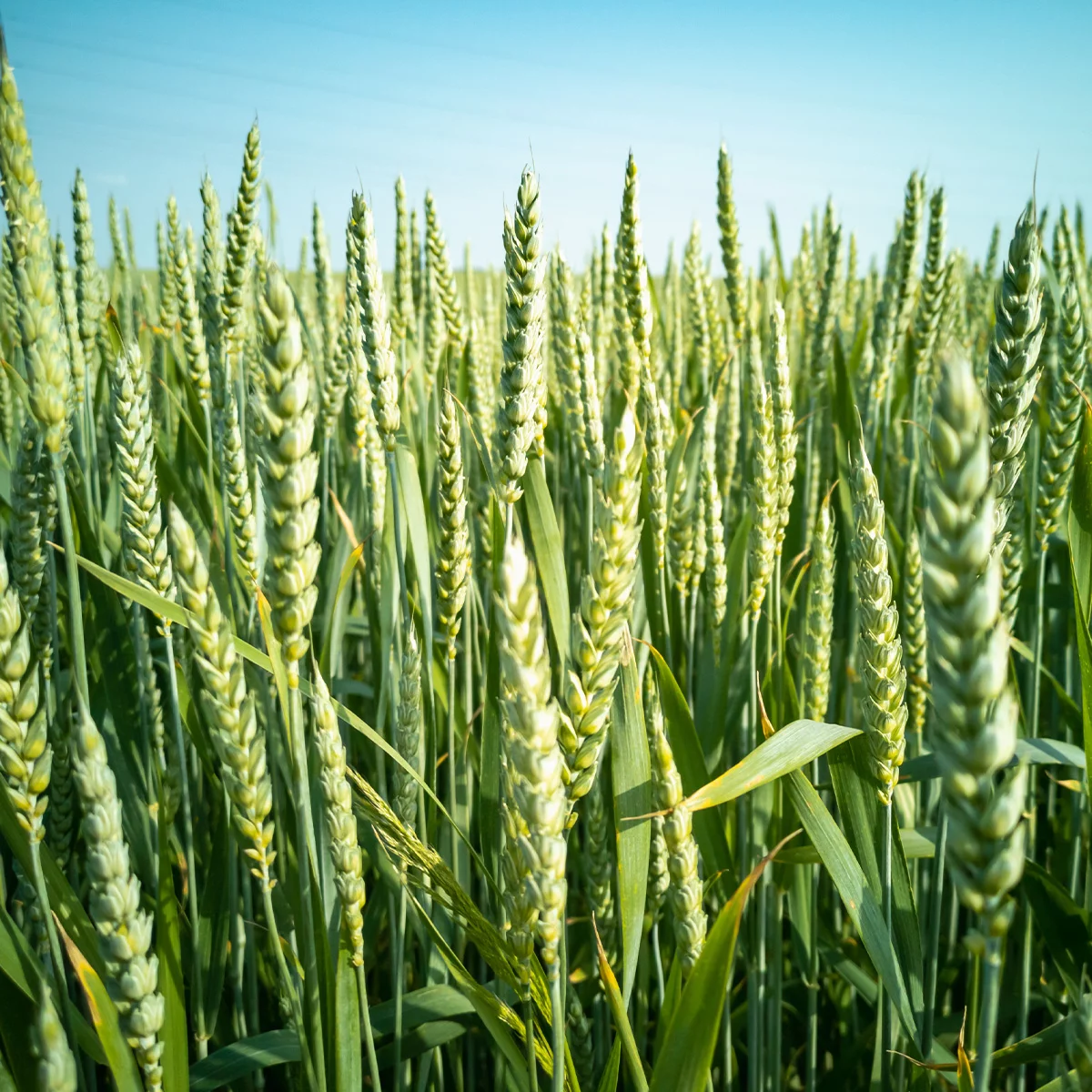
Many experiments under different soil and climatic conditions on many different types of crops have shown increases in both crop productivity and quality due to Si amendment. The efficacy of the application of all kinds of silicon fertilizers has been registered (1): 467 articles up to 2021 were selected, reporting 501 experiments (lab-oriented and field trials), resulting in 682 cases where different Si-based fertilizers were used to study the efficacy of the physiological and/or agronomic performance under specific conditions. In field trials, with the applications of Si-compounds, 69% of results (599) reported yield improvements of between 5-20%, while 18% of the results, registered between 0 and 5%. These improvements were shown in both Si accumulator crops and non-Si accumulator crops, with or without stress. It was also shown that during the last 35 years, the number of published articles on the use of silicon in agriculture, has followed an exponential growth.
Efficacy of silicon on seed germination and seedling growth
Silicon seed-priming trials have been carried to increase seed germination or seedlings vigour and also to cope with several abiotic stresses, such as drought, salinity and alkaline stress (2).
Different Si-compounds have been used for priming, silicates and MSA showing significantly positive effects. In a study with (liquid)-MSA rice seeds were treated with wet coating and overnight soaking. The application of MSA resulted in better seedling vigour along with a
25% increase in seedling length and a 64 % increase in the fresh weight over control seeds (3).
The effects of Si on the maize germination, seedling growth and other characteristics were studied by soaking seeds in solutions of different concentrations of Si, resulting in increased chlorophyll content, osmotic material accumulation and antioxidant defence system activity, reducing membrane system damage, reactive oxygen species contents, and stomatal aperture (4).
Despite the limited trials so far, seed priming with liquid Si formulations shows to be a promising, inexpensive, and user-friendly technology with significant efficacy also in case of abiotic stresses.
Efficacy of silicon on growth parameters, nutrient uptake, and photosynthesis
The efficacy of the solid Si-compounds depends on plant growth and varies, depending on the plant species, environmental conditions, and silicon availability. In several reviews (5; 6) the efficacy of all kinds of Si-compounds, solid as well foliar, is shown.
The application of calcium silicate in wetland rice at several locations, showed improved growth parameters, like: number of tillers, leaf area index and chlorophyll values (SPAD index), and improved yield parameters like the number of panicles per hill, filled grains per panicle, and the grain (+28% to +32%) and straw yield. The uptake of nutrients like P and Ca increased. These yield increases are the result of soil improvement and a higher uptake of MSA (7). Comparative evaluation of the performance of other Si sources like biochar, like rice husk biochar, also showed their importance for increased soil quality and crop improvement (7). The advantage of the use of rice hull biochar, is its use as a recycled product for sustainable rice production (8).
In the literature, positive effects of other Si-compounds are mentioned, such as Diatomaceous earth (DE), Diatomite, Wollastonite (CaSiO3), Talc (MgSiO3), Silica gel, Silicates (such as K2SiO3 and Na2SiO3), Silica blend Industrial by-product: Iron/steel slag, Electric furnace slag, Blast furnace slag, Processing mud, Fly ash and Plant material-based silica such as Miscanthus biochar, fresh rice hull and rice hull ash biochar, and more.
Foliar Silicic Acid (MSA) has been used in agriculture since 2003, when the first field tests were done on potatoes (yield: + 5%) and onions (yield + 11%) (9). Since then, many trials have been made with foliar (stabilized) MSA on all kind of crops such as: papaya (9), rice (10), grapes (11), finger millet (12), cucumber (13), cut rose (14); field peas (15), kinnow mandarin (16), lettuce (17), tobacco (18), soybean (19), okra (20;21), sugarcane (22) and other crops.
In all these trials significant increases in growth parameters, yield and quality were reported. For example, in grapes, an increase was shown in the uptake of nutrients like P, K, Ca, B and also Si. The increase of the Si content was more than the amount applied in the foliar spray showing on increased uptake from the soil.
In another trial it was shown (24) that foliar applied MSA on wheat, enhanced photosynthesis, stomatal conductance, water use efficiency, intercellular CO2 concentration, and significantly decreased the transpiration rate compared to the control, resulting in a significant increase in yield.
Similar results were obtained by the application of nano-silica sprays (25;26).
In a comparative study on the efficacy of rice hull ash (RHA), calcium silicates, silica gel and foliar silicic acid (MSA), on growth and yield of rice, it was shown that all Si-sources increase rice yield, while the efficacy of foliar (stabilized) silicic acid was significantly higher than the other sources of Si.
In a trial on sugarcane, the efficacy of foliar MSA sprays was compared to the soil application of calcium silicates (CS), the combination of foliar MSA/CS and the control. The yield increase for foliar MSA was + 26%, for soil applied CS +14%, and for the combination MSA/CS +33%, all compared to control.
Similar results have been described for the combination of soil application of DE in combination with DE sprays on growth and yield of coffee (26).
Silicon as alleviator of abiotic stresses on crops
Si is the only element which increases the resistance of plants to multiple stresses (29), as well as abiotic stresses (drought, heat/radiation, salinity, acidity, metal toxicity, cold/freezing) and biotic stresses.
The main mechanisms for alleviating stresses by Si application are based on:
- a) higher uptake of silicon deposited as silica in cell walls, strengthening the plant and functioning as a physical (mechanical) barrier in plants, and
- b) influencing metabolic/physiological activities, especially in case of (multiple) stresses (30).
Drought and heat
Drought stress is an increasing problem almost worldwide, due to the implications of climate change. The role and importance of Silicon application has been shown to be based on several mechanisms:
- a) the silica layer in cell walls of xylem vessels prevents compression of the vessels in case of high transpiration caused by drought or heat stress. The silica layer in epidermal tissue protects plants against excessive loss of water by transpiration, due to the closure of the stomata resulting in a reduction in leaf transpiration (31;32).
- b) Si is also involved in the regulation of antioxidant enzymes which is one of the first main lines of defence against water deficit stress.
In the last decade, positive effects have been found on the application of several silicon compounds (like Na -, K -, Ca – and Mg silicates, silicon slags) on the reduction of drought/heat stress for cereals (wheat, rice, maize, sorghum), pulses (mung bean, cowpea, chickpea), oilseeds (sunflower), vegetables (tomato, pepper) and others (chestnut and pistachio) (33). The application of foliar MSA increased the relative water content, leaf chlorophyll content and lower canopy temperatures (34).
Drought/heat can have a negative impact on growth especially in extreme situations. In 2018, the applications of foliar OSAB (= MSA) increased the growth of pumpkins in the dessert region in South Algeria (photo 1 and 2).
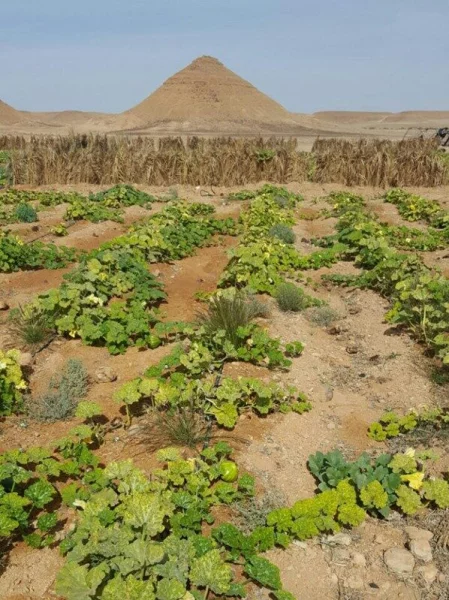

Photo 1 and Photo 2. The effect of applying foliar sprays with OSAB (= MSA) on pumpkins in the south of Algeria in 2018. Control plants: left; Si-treated plants: right;. Photo: @ Rexil-Agro BV
Salinity
The mechanisms for improving salt stress tolerance include (35):
- a) reduced sodium uptake: Silicon can reduce the uptake of sodium (Na+) ions by plant roots. Silicon enhances the selectivity of ion uptake, favouring the uptake of beneficial elements such as potassium (K+) over sodium. This selective uptake helps to maintain a more favourable ion balance in plant tissues under salt stress conditions.
- b) enhanced antioxidant defence system: Salt stress can lead to the production of reactive oxygen species (ROS) in plants, which causes oxidative damage to cellular components. Silicon enhances the activity of antioxidant enzymes such as superoxide dismutase (SOD), catalase (CAT), and peroxidase (POD). These enzymes help to detoxify ROS and protect plant cells from oxidative stress (36).
- c) Strengthening cell walls by the deposition of a layer of silica, providing physical barriers against salt penetration. This mechanism helps to reduce the movement of salt ions from the roots to the shoots, preventing their toxic effects on plant tissues.
- d) Improved water relations: salt stress can disrupt the water balance in plants, leading to water deficit and reduced plant growth. Silicon can improve the water relations in plants under salt stress, by enhancing the uptake and transport of water. It helps to maintain the integrity of cell membranes and regulate stomatal conductance, thus reducing water loss through transpiration being a similar mechanism under drought stress.
- e) Regulation of gene expression: Silicon influences the expression of genes involved in several stress situations including salt stress. By upregulating the expression of stress-related genes, including those encoding osmo-protectants, transporters, and stress signalling proteins. This gene regulation by silicon (application) is important to enhance the plant’s ability to cope with most stresses.
The application of extra silicon on wheat, grown in saline soil, resulted in an increased sodium exclusion and increased activity of antioxidant enzymes (36). Also, decreased plasma membrane permeability and increased root activity, resulting in a higher uptake of nutrients in barley (37).
Applications of foliar AB Yellow (= MSA) on wheat, grown in very salty soil in Romania, increased the yield. In a trial on two plots of 1,8 and 2,1 ha, the efficacy of foliar applied MSA sprays was compared to control. No NPK’s were used. The yield of the control was 1050 kg/ha and 3100 kg/ha from the treated plot (photo 3).
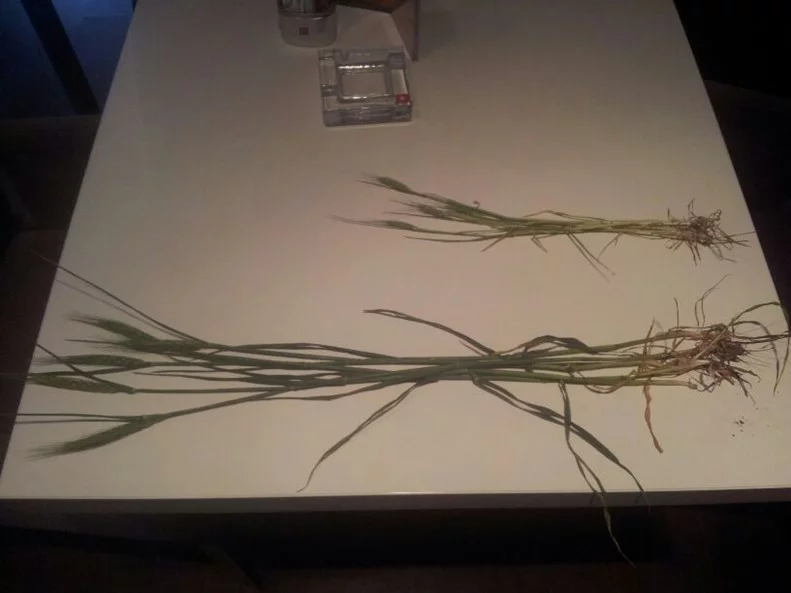
Photo 3. The effect of applying foliar sprays with AB Yellow (= MSA) on wheat grown in very salty soil in the east of Romania in 2014. Si-treated: lower plant; untreated control: upper plant. Photo: @ Rexil-Agro BV
Acidity
Silicon (Si) can improve acidity stress tolerance in plants. Some of the mechanisms are:
a) Aluminium detoxification. The presence of toxic aluminium (Al) ions can cause acidity. Silicon reduces the Al toxicity by forming complexes with Al ions in the root zone reducing the uptake and translocation within the plant, preventing the toxic effects of Al on root growth and other physiological processes (38).
b) Stabilization of cell membranes. Acidity stress can disrupt the integrity of cell membranes. Silicon can enhance the stability of cell membranes, thus protecting them from acid-induced damage. This stabilization is important for the integrity of cellular structures and to improve plant functions under acidity stress conditions (39).
c) Regulation of nutrient uptake. Silicon can affect the uptake and translocation of essential nutrients in plants. Under acidity stress, the availability and uptake of nutrients, such as phosphorus (P), calcium (Ca), and magnesium (Mg), can be impaired. Silicon has been reported to enhance the uptake and translocation of these nutrients, thereby improving the nutrient balance in plants, promoting their overall growth and development (40).
d) Enhancement of antioxidant defence. Like other abiotic stresses, acidity stress can increase reactive oxygen species (ROS) in plant cells. Silicon has been shown to enhance the activity of antioxidant enzymes, such as superoxide dismutase (SOD), catalase (CAT), and peroxidase (POD), which scavenge ROS and protect plants from oxidative damage. This antioxidant defence mechanism helps plants cope with acidity stress-induced oxidative stress (41).
e) Modulation of gene expression: Silicon can regulate the expression of genes involved in acidity stress responses including those encoding organic acid transporters, ion channels, and enzymes involved in the detoxification processes. By modulating gene expression, silicon helps plants adapt and respond more effectively to stresses including acidity stress (42), photo 4 and 5.
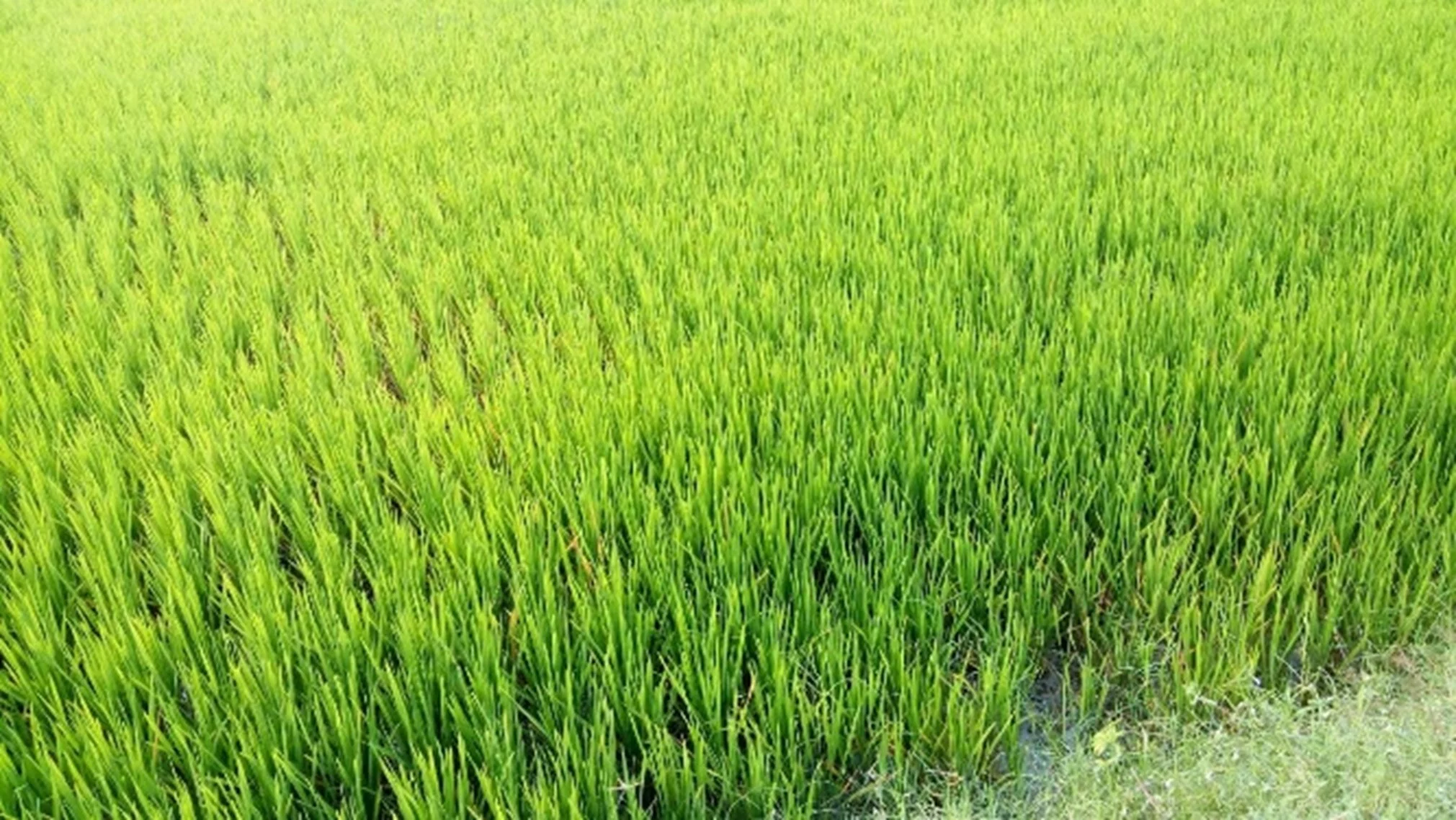
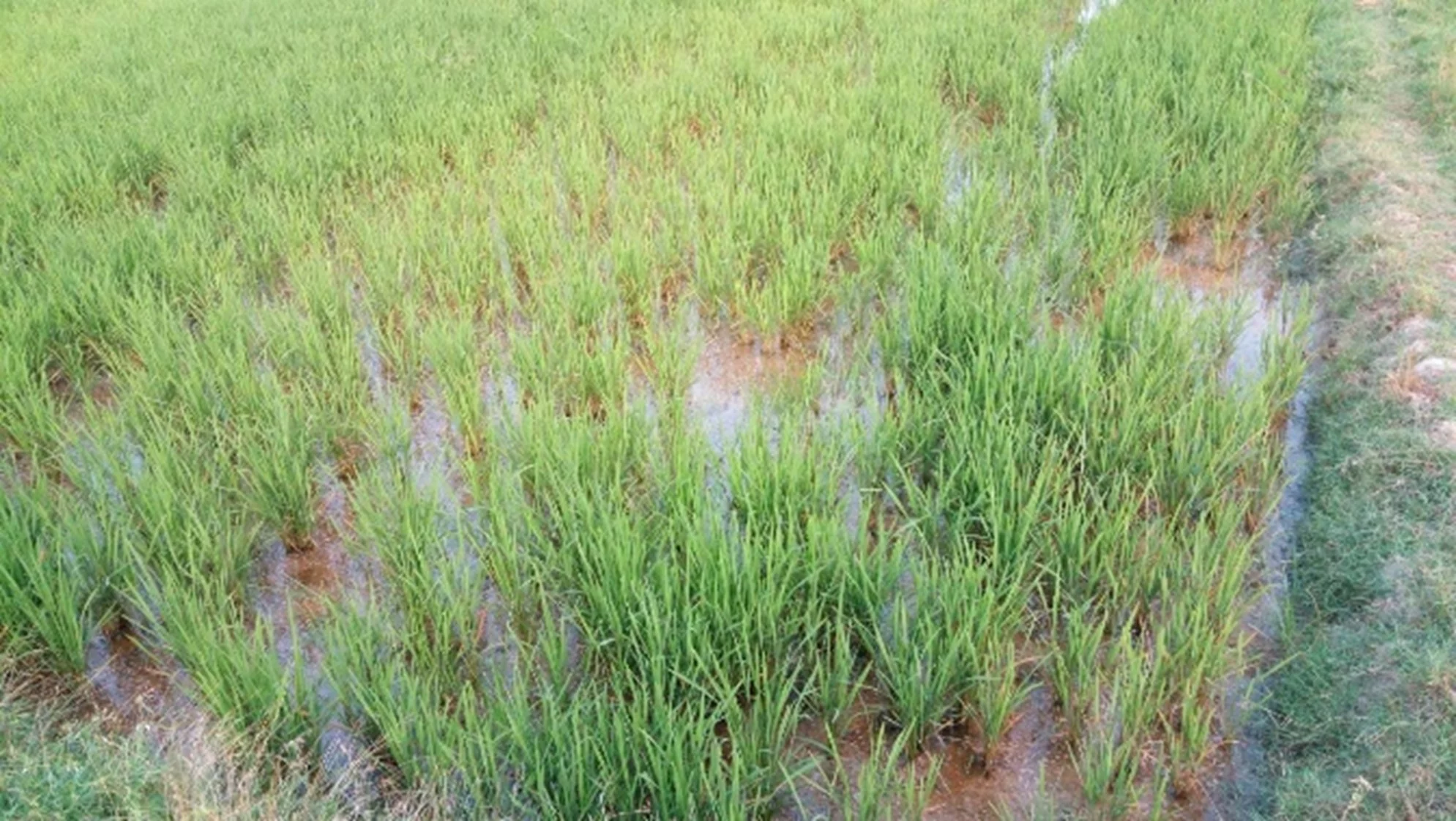
Photo 4 and Photo 5. The effect of applying foliar sprays with AB Yellow (= MSA) on rice grown in very acidic soils in Tamil Nadu, India in 2016. Si-treated: left, and untreated control : right. Photo: @ Rexil-Agro BV
Wind and storm
Due to climate change, the influence of strong winds and storms is increasing. Silicon compounds can improve the structural strength of plants and trees for the following reasons:
- a) The application of silicon compounds can increase the root mass resulting in better anchoring in the soil. After uptake, silicon deposition as silica, strengthens plant cell walls. Silicon can also promote the production of lignin, important for rigidity and strength, by upregulating lignin biosynthesis genes. As a result, plant tissues become more resistant to bending and breaking under the stress of wind or storms (photo 6).
- b) Enhanced stem and leaf rigidity: Silicon can increase the stiffness of plant stems and leaves making them more rigid, helping plants/trees to maintain their upright position and reducing the risk of structural damage like lodging or breaking (43;44).
- c) Reduced transpiration and water loss: Silicon can reduce transpiration rates. By decreasing transpiration, silicon can help plants conserve water during windy conditions. This enhanced water-use efficiency can contributes to plant survival and reduce the risk of dehydration during storms (32).
d) Defence against pathogens and pests: Silicon deposition in plant tissues also enhances the resistance to pathogens and pests. Stronger cell walls make it more difficult for pathogens to penetrate and infect plant tissues. By protecting against disease and pest damage, plants are better equipped to withstand environmental stresses, including those caused by wind and storms (45).
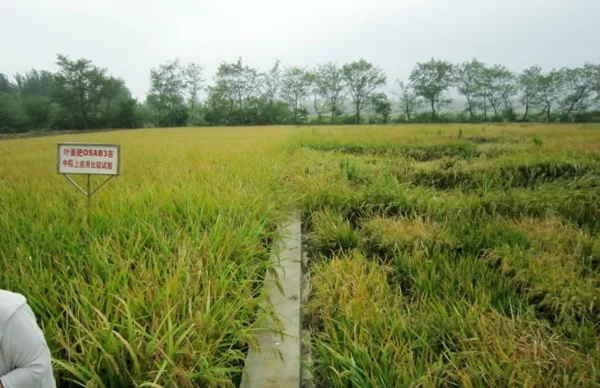
Photo 6. Trial on Rice (China 2011): left MSA application, right: control. The effects of a storm resulted in lodging of the rice in the control plot. Result: a 32% higher grain yield and an increased nutrient and mineral content in the rice grains. Photo: @ Rexil-Agro BV
Cold and freezing
Low temperature is an important abiotic stress factor for plants. The supplementation with Si reduces frost damage in monocots as dicots. Mechanisms for the effect of Si on relieving cold stress are related to an increased structural strength of the cell wall and the biochemical adaptations to stress including exacerbation of antioxidant defence system and synthesis and accumulation of cryo-protecting molecules, in parallel to the modifications in the endogenous levels of phytohormones. Silicon can help regulate antioxidant systems within the plant, reducing ROS accumulation and protecting against oxidative stress.
Si also influences the biophysical and biochemical properties of the leaf for the cold acclimation process and increases the resistance to frost damage: silicon can influence the formation and growth of ice crystals in plant tissues. Silicon-treated plants tend to have smaller and fewer ice crystals, minimizing damage to cells and tissues during freezing (46).
Silicon can enhance photosynthetic efficiency in plants under various stress conditions. By improving photosynthesis, silicon-treated plants can maintain higher energy levels and better tolerate cold stress.
Metal toxicity
Soil contamination with trace elements results in major physiological disturbances including reduced biomass production, photosynthesis inhibition, or disturbance of nutrient uptake (47).
Si can reduce toxicity symptoms, for example Iron. Si increases the oxidizing capacity of roots, which converts ferrous iron into ferric iron, thereby preventing a large uptake of iron and limiting its toxicity. It has been reported that Si can regulate Fe uptake from acidic soils when supplemented with Si.
Silicon can reduce the effects of Aluminium (Al). Si and Al interact in the soil, forming aluminosilicates, reducing phytotoxic aluminium concentration in the soil solution, which is not plant available. Inside the plant aluminium can be detoxified by forming (hydroxy) aluminosilicates in roots, or by a sequestration in phytoliths, reducing Al toxicity in the shoots.
Manganese (Mn) toxicity is reduced in Si-fertilized plants because Si increases Mn binding to cell walls, which limits cytoplasmic concentrations. Si application has been shown to lower the apoplastic Mn concentration in cowpea leaves. It also induces a more homogenous distribution of Mn in leaves, limiting spot necrosis.
Si can limit the uptake of trace metals like Cadmium (Cd), Copper (Cu) and Zinc (Zn). Overall, Si application decreases metal concentrations in plants.
A reduced uptake of Cd after rice fertilization with furnace slag, has been attributed to an increase in soil pH, thereby limiting Cd uptake, a reduction in root–shoot translocation, and changes in compartmentation within the plant cell. The application of calcium silicate decreased Cd and Zn concentrations in maize shoots grown on Cd- or Zn-contaminated soil.
Si affected zinc inside the plant since zinc can co-precipitate with Si in cell walls leading to less soluble zinc in plants. In addition, foliar application of Silicic acid decreased Cd concentration in rice grains and shoots, while increasing their biomass. Silicic acid also decreased arsenic (As) concentration in rice shoots grown in hydroponics.
Silicon as alleviator of biotic stresses on crops
Beneficial effects of Si have been demonstrated against many pathogens caused by living organisms such as a. diseases caused by fungi, bacteria, and virus, and pests, such as arthropods (insects and mites), nematodes (worms), molluscs (snails and slugs) and rodents (rats, mice).
The mechanisms involved are:
- Mechanical: bio-silicification: a layer of silica is formed in the cell wall providing physical barriers against the penetration of spores from fungi such as powdery mildew, Septoria and eyespot in wheat and stalk rot, rice blast, fusarium, tan spot, and leaf spots in rice (29) and other fungal species for many agricultural crops.
The silica layer can act as a deterrent to herbivores and reduce the damage caused by insect feeding. It makes the leaves less palatable and affects insect growth and survival.
- Biochemical defence: Induced (systemic) resistance: silicon treatment can trigger systemic acquired resistance (SAR) in plants. SAR is a plant’s systemic response to localized infection, leading to enhanced resistance against subsequent infections by the same or related pathogens by the production of defence compounds, such as phytoalexins, pathogenesis-related proteins, and antioxidants. This systemic resistance can provide long-lasting protection to the entire plant (48).
- Regulation of plant hormones: Silicon can modulate the balance of plant hormones, particularly jasmonic acid (JA) and salicylic acid (SA), which play crucial roles in plant defence responses. Silicon enhanced the JA-mediated defence pathway, which is involved in defence against herbivores (49).
In trials on rice (high Silicon accumulating plant species) the maximum grain yield was recorded with the treatments receiving foliar MSA sprays and half dose of pesticides/fungicides being more effective in grain and straw yield increases compared to controls with 100% pesticide/fungicide dosing (50). But even only foliar applications of MSA (without pesticides/fungicides applications) appeared more effective compared to control (with full doses of pesticides/fungicides).
In low Silicon accumulating plants without silica layers, the efficacy of Si is still significant.
The applications of Silicon reduced the severity of Phytophthora infestans (water mold, a fungus-like fungus) in tomato. Several types of Silicon sprays showed inhibitory effects (1.11 to 90.37 %) over the untreated control. The MSA sprays recorded the highest mean mycelial growth inhibition, significantly more compared to the sprays with silicates (37).
In another trial the effects of foliar OSAB (= MSA) sprays were examined for reducing damage from two major pests, Bemisia tabaci and Tuta absoluta in tomato plants. The results showed that foliar MSA significantly decreased the population of both immature whiteflies and tomato leaf miners on a tomato crop in the greenhouse. Foliar MSA sprays were more effective in reducing the population density of these key pests, compared to MSA-soil drench application (52).
In conclusion, silicon bolsters plants defence mechanisms, reducing the impact/damage of biotic stresses – depending on plant species, soil properties, climatic conditions and the specific biotic stress factors involved. Silicon isn’t a ‘pesticide’, but an essential element for many plants.
Overall, Si application is a promising strategy in management programs for reducing biotic stresses, also due the ecological and safety aspects of Si products.
Beneficial effects of silicon application on soil
Silicon fertilizers, mostly silicates, can have several beneficial effects on the soil. Silicon can contribute to the formation of stable soil aggregates, improving soil structure and stability. It promotes the binding of soil particles, enhancing soil porosity, water infiltration, and drainage. This can result in better soil aeration, root development, and overall soil health.
In soils with high levels of toxic elements like aluminium and manganese, silicon fertilizers can help alleviate their toxic effects on plants. Silicon forms complexes with these toxic metals, reducing their availability and uptake by plants. This can prevent or mitigate the negative impacts of metal toxicity on plant growth and productivity.
Silicon and quality of the produce
In the last century, the internal quality of many crops has declined resulting in lower mineral and vitamin content of vegetables, also containing chemical residues (44). Do we need to eat two lettuces today to obtain the same nutritional value as one lettuce in 1950? Up until now, pesticides residues detected fruits and vegetables, have also been too high. The (excessive) use of pesticides & fungicides can be detrimental to soil fertility, by destroying beneficial microorganisms and decreasing the concentration of plant available Si.
New production methods, such as: soilless culture, aquaponics, vertical towers, etc., are all finding new interest and markets. Yet, what comparative examinations are being made to test the internal quality of this produce, including the content of chemical residues and water? Such testing should be done on a routine basis by grower cooperatives and supermarket chains, also for the sake of the consumer.
Methods of production have an important effect on plant physiology and metabolism during growth and development, that also translates to internal produce quality and shelf-life. In this more holistic sense, the application of silicon during production has a highly beneficial effect on internal quality and shelf-life. Yet, the entire chain from production to consumer is still orientated toward external product quality and yield, e.g.: size, shape, appearance, uniformity and storage qualities (53).
The use of foliar MSA on grapes (12), showed improved growth parameters: an increased chlorophyll content, total soluble solids and sugar. The fruit mineral content was increased for P, K, Ca. The increase of the Si content was more than the amount applied in the foliar spray. Similar observations were recorded in many other species.
Tougher fruit skins improve resistance against mechanical damage in transport and deter insect attack. In trials with foliar MSA on grapevines, the grape skins were thicker and tougher, resulting in significantly longer shelf life (58). Similar results were reported for many other fruits, like strawberries, apples, pears, tomato, together with significant reductions in disease infections and pest damage.
In monocots, like wheat, rice, etc. the internal quality was improved in the case of protein levels.
In trials in 2010-2011 on sugarcane, foliar MSA induced significantly higher yields in terms of increases in brix and natural raw sugar. Similar results were reported in another trial with foliar MSA on sugarcane (23)
1
Barão L (2023) The Use of Si-Based Fertilization to Improve Agricultural Performance. J Soil Sci Plant Nutr 23, 1096–1108. https://doi.org/10.1007/s42729-022-01106-1
2
Hernandez-Apaolaza L (2022) Priming with Silicon: A Review of a Promising Tool to Improve Micronutrient Deficiency Symptoms. Front. Plant Sci. 13:840770. doi: 10.3389/fpls.2022.840770
3
Neeru J, Shalies C, Vaishali T et al (2019) Role of Orthosilicic Acid (OSA) Based Formulation in Improving Plant Growth and Development. Silicon 11, 2407–2411. https://doi.org/10.1007/s12633-015-9380-x
4
Sun, Y., Xu, J., Miao, X., Lin, X., Liu, W., and Ren, H. (2021). Effects of exogenous silicon on maize seed germination and seedling growth. Sci. Rep. 11:1014. doi: 10.1038/s41598-020-79723-y
5
Zellner W, Datnoff L (2022) Silicon as a biostimulant in agriculture. Chapter taken from: Rouphael Y, du Jardin P, Brown P, De Pascale S, Colla G. (ed.) (2022) Biostimulants for sustainable agriculture, Burleigh Dodds Science Publishing, Cambridge, UK, 2020, (ISBN: 978 1 78676 336 5)
6
Laane HM (2018) The Effects of Foliar Sprays with Different Silicon Compounds. Plants 7: 1-22.
7
Sandhya TS, Prakash NB (2017) Evaluation of calcium silicate, rice hull and rice hull ash as silicon sources in wetland rice in acidic and alkaline soils. J Indian Society of Soil Science 65, 428-434
8
Shetty R, Prakash NB (2020) Effect of different biochars on acid soil and growth parameters of rice plants under aluminium toxicity. Scientific Reports. https://doi.org/10.1038/s41598-020-69262
9
Meena VD, Dotaniya ML, Coumar V et al (2013) Case for Silicon Fertilization to Improve Crop Yields in Tropical Soils. Proc. Natl. Acad. Sci. India Sect. B Boil. Sci. 2013, 84: 505–518
10
Realpe OHR, Laane HM (2008) Effect of the foliar application of soluble oligomeric silicic acid and low dose of boric acid on papaya trees. Proc 4th Int Conf on Silicon in Agriculture, South Africa, abstract 94
11
Praskash NB, Chandrashekar N, Mahendra C et al (2011) Effect of foliar spray of soluble silicic acid on growth and yield parameters of wetland rice in hilly and coastal zone soils of Karnataka, South India. J of Plant Nutr 34, 1883–1893
12
Bhavya HK, Nachegowda V, Jaganath S et al (2011) Effect of foliar silicic acid and boric acid in Bangalore blue grapes. Proc 5th Int Conf on Silicon in Agriculture, China, p7
13
Sandhya TS, Prakash NB, Nagaraja A et al (2011) Genotypic variation for silicon accumulation and effect of foliar silicic acid on growth and yield of Finger millet (Eleucine coracana L.). Proc 5th Int Conf on Silicon in Agriculture, China, p.183
14
Olle M (2014) The effect of silicon on the organically grown Cucumber transplants growth and quality. 16th World Fertilizer Congress of CIEC
15
Chikkur S, Prakash NB, Parameshwar AS et al (2015) Effect of foliar silicic acid on growth and yield attributes of Rose cut flowers (Rosa hybrid L.). Plant Archives 15, 931-937.
16
Olle M, Schnug E (2016) The influence of foliar applied silicic acid on N, P, K, Ca and Mg concentrations in field Peas. J für Kulturpflanzen 68 (1) 7–10, ISSN 1867-0911, DOI: 10.5073/JFK.2016.01.02
17
Verma V, Goyal V, Bubber P, Jain N (2017) Effect of foliar spray of stabilized silicic acid (OSA) on the fruit quality and quantity of Kinnow Mandarin. Proc 7th Int. Conf. on Silicon in Agriculture, India, p. 147.
18
Olle M. (2017) The effect of silicon on the organically grown Iceberg Lettuce growth and quality. J Agricultural Science 2. 82–86.
19
Vageesh TS, Nataraju SP, Prakash NB et al (2011) Growth of seedlings and drought tolerance in Tobacco as influenced by Si nutrition.Proceedings of the 5th Int Conference on Silicon in Agriculture, China, p. 194-195.
20
Shwethakumari U, Prakash NB (2018) Effect of foliar application of silicic acid on Soybean yield and seed quality under field condition. J Indian Society Soil Science 66, 406-414.
21
Vashi JM, Tandel BM, Saravaiya SN, Patel AI, Chaudhar BN (2019) Response of Okra (Abelmoschus esculentus L.) to Foliar Application of Silicon Int J Curr Microbiol App Sci 8(8):1277-1282
22
Diwan SB, Mohammedtarik Saiyad, Dhruve JJ (2019) Effect of foliar application of silicon on growth and development of Okra fruit. J. of Pharmacognosy and Phytochemistry 8(2):1552-1558
23
Jain R, Singh A, Jain N. et al. Response of Silixol Sugarcane to Growth and Physio-Biochemical Characteristics of Sugarcane. Sugar Tech 20, 439–444 (2018) https://doi.org/10.1007/s12355-017-0557-z
24
Jeer M, Yele Y, Sharma KC, Prakash NB (2020). Exogenous application of different silicon sources and potassium reduces pink stem borer damage and improves photosynthesis, yield and related parameters in wheat. Silicon. (DOI:10.1007/s12633-020-00481-7)
25
Xie Y, Li B, Tao G et al (2012) Effects of nano-silicon dioxide on photosynthetic fluorescence characteristics of Indocalamus barbatus McClure. J. Nanjing For. Univ. (Nat. Sci. Ed.) 2, 59–63
26
Gokavi N, Jayakumar M, Mote K, et al. (2021) Diatomaceous Earth as a Source of Silicon and its Impact on Soil Physical and Chemical Properties, Yield and Quality, Pests and Disease Incidence of Arabica Coffee cv. Chandragiri. Silicon 13, 4583–4600 https://doi.org/10.1007/s12633-020-00767-w
27
Nazaralian, S, Majd, A, Irian S et al (2017) Comparison of silicon nanoparticles and silicate treatments in fenugreek. Plant Physiol Biochem 15, 25–33
28
Prakash NB, Chandrashekhar N (2011) Response of Rice to soil and foliar applied silicon sources. Proc 5th Int Conf on Silicon in Agriculture, Beijing, China, p151.
29
Ma JF (2004) Role of silicon in enhancing the resistance of plants to biotic and abiotic stresses. Soil Sci Plan. Nutr 50: 11-18
30
Sacala, E (2009) Role of silicon in plant resistance to water stress. J Elem 14: 619-630. DOI:10.5601/jelem.2009.14.3.20
31
Meena VD, Dotaniya ML, Coumar V et al (2014) A case of silicon fertilization to improve crop yields in tropical soil. Proc. Nat. Acad. Sci. India Section B: Biological sciences., 84: 505-518.
32
Shi Y, Zhang Y, Han W et al (2016) Silicon enhances water stress tolerance by improving root hydraulic conductance in Solanum lycopersicum L Front Plant Sci 7: 1-15
33
Sapre SS, Vakharia DN (2016) Role of silicon under water deficit stress in wheat: (Biochemical perspective): A review. Agricultural Reviews, 37 2 109-116 DOI: 10.18805/ar.v37i2.10736
34
Passala R, Jain N, Deokate P et al (2014). Assessment of silixol (= MSA) efficacy on wheat physiology: growth and nutrient content under drought conditions. Proc 6th Int Conf on Silicon in Agriculture, Sweden p138
35
Zhu YX, Gong HJ, Yin JL (2019) Role of Silicon in Mediating Salt Tolerance in Plants: A Review. Plants (Basel) 31;8(6):147. doi: 10.3390/plants8060147.
36
Saqib M, Zorb C, Schubert S (2008) Silicon-mediated improvement in the salt resistance of wheat (Triticum aestivum) results from increased sodium exclusion and resistance to oxidative stress. Functional Plant Biology 35:633–639
37
Liang YC, Chen Q, Liu Q, Zhang WH, Ding RX (2003) Exogenous silicon (Si) increases antioxidant enzyme activity and reduces lipid peroxidation in roots of salt-stressed barley (Hordeum vulgare L.). Journal of Plant Physiology 160:1157–1164
38
Hodson MJ, Evans DE 2020) Aluminium-silicon interactions in higher plants: an update. J Exp Bot. 2;71(21):6719-6729. doi: 10.1093/jxb/eraa024.
39
Bhardwaj S, Sharma D, Singh S et al (2023) Physiological and molecular insights into the role of silicon in improving plant performance under abiotic stresses. Plant Soil 486: 25–43 doi.org/10.1007/s11104-022-05395-4
40
Kumari A, Sharma B, Singh BN et al (2022) Chapter 10 – Physiological mechanisms and adaptation strategies of plants under nutrient deficiency and toxicity conditions. Plant Perspectives to Global Climate Changes, Academic Press, pp 173-194,
https://doi.org/10.1016/B978-0-323-85665-2.00012-1.
41
Castro B, Citterico M, Kimura S et al (2021 Stress-induced reactive oxygen species compartmentalization, perception and signalling. Nat. Plants 7, 403–412 https://doi.org/10.1038/s41477-021-00887-0
42
Manivannan A, Ahn YK (2017) Silicon Regulates Potential Genes Involved in Major Physiological Processes in Plants to Combat Stress. Front Plant Sci 3;8:1346. doi: 10.3389/fpls.2017.01346
43
Daqiu Zhao D, Xu C, Luan Y et al (2021 ) Silicon enhances stem strength by promoting lignin accumulation in herbaceous peony (Paeonia lactiflora Pall.). Int J of Biological Macromolecules, 90:769-779 doi.org/10.1016/j.ijbiomac.2021.09.016.
44
Bent E (2014) Silicon Solutions – Helping Plants to Help Themselves. Sestante: Bergamo, Italy p 1-183. ISBN 978-88-6642-151-1
45
Frew A, Weston LA et al (2018) The role of silicon in plant biology: a paradigm shift in research approach. Annals of Botany, 121-7: 1265–1273. https://doi.org/10.1093/aob/mcy009
46
Hajiboland R (2022) Silicon-mediated cold stress tolerance in plants, Chapter in Silicon and Nano-silicon in Environmental Stress Management and Crop Quality Improvement, Academic Press, p 1612-180. doi.org/10.1016/B978-0-323-91225-9.00013-3.
47
Guntzer F, Keller C, Meunier JD (2012) Benefits of plant silicon for crops: a review. Agron. Sustain. Dev. 32:201–213 DOI 10.1007/s13593-011-0039-8
48
Gao H, Guo M, Song J et al (2021) Signals in systemic acquired resistance of plants against microbial pathogens. Mol Biol Rep 48, 3747–3759. doi.org/10.1007/s11033-021-06344-7
49
Singh S, Sahoo MR, Acharya GC et al (2022) Silicon: a Potent Nutrient in Plant Defense Mechanisms Against Arthropods. Silicon 14, 6493–6505. doi.org/10.1007/s12633-021-01427-3
50
Prakash NB, Chandrashekar N, Mahendra C, et al (2011) Effect of foliar spray of soluble silicic acid on growth and yield parameters of wetland rice in hilly and coastal zone soils of Karnataka, South India. J Plant Nutr., 34:12, 1883-1893. doi.org/10.1080/01904167.2011.600414
51
Kedarnath G, Rangaswamy KT, Prakash NB et al (2016) In vitro evaluation of silicon sources against late blight (Phytophthora infestans) of tomato. Int J Science Nature 7 (4) 881-884
52
Alyousuf A, Hamid D, Desher MA et al (2022) Effect of Silicic Acid Formulation (Silicon 0.8%) on Two Major Insect Pests of Tomato under Greenhouse Conditions. Silicon 14, 3019-3025. doi.org/10.1007/s12633-021-01091-7
53
Bent E (2022) PLANT-LIFE, a Walk with Nature. Holistic vision of nature including the importance of silicon to climate change and stresses Cpt 13,183-185. ISBN_79-12-210-0957-6 and www.nartura.net
54
More information on biostimulants: www.biostimulant.com



